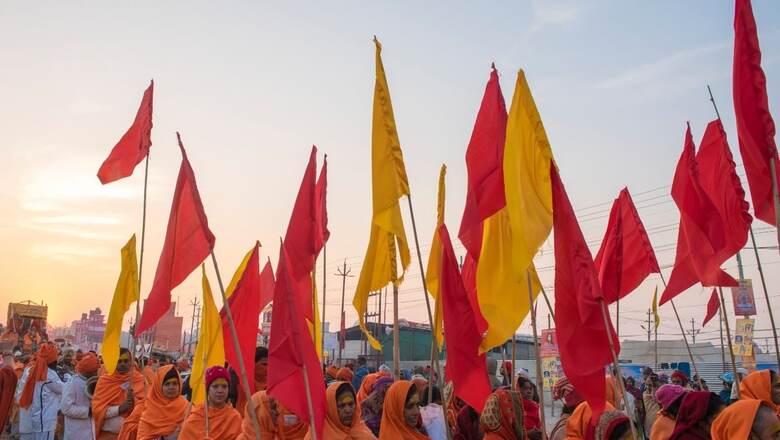
views
Democratic Progressive Azad Party (DPAP) chief and former Chief Minister of Jammu and Kashmir, Ghulam Nabi Azad, recently gave a statement that the majority of Indian Muslims have converted to Islam from Hinduism.
This is what Azad said: “In the parliament, once some BJP leader said some (Muslims) have come from outside and some have not. I said no one has come from outside. Islam came into existence just 1,500 years ago. The Hindu religion is very old. Around 10-20 of them (Muslims) might have come from outside. Some were there in the Mughal army. The rest of them converted from Hinduism in India. Kashmir is an example of it. Who were the Muslims in Kashmir some 600 years ago? All were Kashmiri Pandits. They converted to Islam. I am saying all were born in this (Hindu) dharma only.”
Azad’s statement attracted strong reactions from a section of Indian politicians sparking a debate. This isn’t a new debate, it gets re-ignited now and then, in both the domestic and global arenas. The issue at the core of this debate is: Who is a Hindu?
Who is a Hindu?
There have been many definitions of the term ‘Hindu’. But the most commonly accepted definition is that it was a term used to denote a civilisation that carried certain cultural values that were imbibed in the concept of ‘dharma’. There is no equivalent term in English for ‘dharma’, though the closest is righteousness, perhaps. Most of the fallacies in understanding ‘Hindu Dharma’ has emerged due to the misinterpretation of the term ‘dharma’ as religion.
‘Dharma’ is a Sanskrit term and it means a way of life whereas ‘religion’ denotes a way of worship. Dharma in practice comprises the unchanging, eternal, universal laws and the ever-changing socio-economic order in the light of these laws. Perceived oneness in the midst of all diversities (Avibhaktam Vibhakteshu) has been the eternal message of Sanatana Dharma or Hindu Dharma.
In the early years of the 20th century, religion was used interchangeably with the word dharma due to impact of the British colonialism on Indian public discourse. Similarly, many philosophers used the word ‘Hinduism’ also, including Swami Vivekananda. However, ‘ism’ also denotes a dogma such as ‘capitalism’, ‘socialism’ etc. When we talk about ‘ism’, we are talking about a certain set of rigid rules that create an ideological framework. But ‘Hindu Dharma’ isn’t a dogmatic framework. Hence, many Indian philosophers also used these terms interchangeably while writing in English on Hindu philosophy, history, culture and civilisation in the 19th and 20th centuries due to the constraints of colonialism.
It is most evident from the writings of Sri Aurobindo, who initially talked about the Hindu ‘religion’ in his famous Uttarpara Speech. But in his later works, he elaborated upon Hindu ‘Dharma’. Dr S Radhakrishnan and Radha Kumud Mookerji also followed the same path.
So, as we move ahead, the word ‘religion’ used by the Indian philosophers and ideologues may be read as ‘dharma’ as that was their intent. The word ‘Sanatana’ means eternal and as Hindu Dharma is considered to be eternal so ‘Sanatana Dharma’, Hinduism, Hindu religion and ‘Hindu Dharma’ had been used interchangeably. But the true essence of Hindu civilisation can be explained by the words Hindu Dharma and Sanatana Dharma. It would help the readers to read the word ‘religion’ as ‘dharma’ whenever used in the quotes of the early 19th and 20th century Indian philosophers.
In his famous speech delivered at Uttarpara Jaikrishna library on May 30, 1909, Sri Aurobindo said, “What is the Hindu religion? What is this religion which we call Sanatana, eternal? It is the Hindu religion only because the Hindu nation has kept it, because in this Peninsula, it grew up in the seclusion of the sea and the Himalayas because in this sacred and ancient land, it was given as a charge to the Aryan race to preserve through the ages. But it is not circumscribed by the confines of a single country, it does not belong peculiarly and forever to a bounded part of the world. That which we call the Hindu religion is really the eternal religion because it is the universal religion which embraces all others. If a religion is not universal, it cannot be eternal. A narrow religion, a sectarian religion, or an exclusive religion can live only for a limited time and a limited purpose. This is the one religion that can triumph over materialism by including and anticipating the discoveries of science and the speculations of philosophy.”
“It is the one religion which impresses on mankind the closeness of God to us and embraces in its compass all the possible means by which man can approach God. It is the one religion which insists every moment on the truth which all religions acknowledge that He is in all men and all things and that in Him we move and have our being. It is the one religion which enables us not only to understand and believe this truth but to realise it with every part of our being. It is the one religion which shows the world what the world is, that it is the Lila of Vasudeva. It is the one religion which shows us how we can best play our part in that Lila, its subtlest laws and its noblest rules. It is the one religion which does not separate life in any smallest detail from religion, which knows what immortality is and has utterly removed from us the reality of death,” he further said.
One of the most commonly acceptable viewpoints is that in addition to the civilisational value system, the word ‘Hindu’ was also rooted in certain geographical contexts. Dr S Radhakrishnan, a renowned philosopher who also became the President of India, delivered four lectures in 1926 at Manchester College, Oxford where he dwelt upon Hindu Dharma in detail. According to him, the Hindu civilisation is so called, since its original founders or earliest followers occupied the territory drained by Sindhu (the Indus) river system corresponding to the North-West Frontier Province and Punjab. This is recorded in the Rig Veda, the oldest of the Vedas, the Hindu scriptures which gave their name to this period of Indian history. The people on the Indian side of the Sindhu were called Hindu by the Persians and the later Western invaders.
According to Dr Radhakrishnan, “The Hindu philosophy of religion starts from and returns to an experimental basis. Only this basis is as wide as human nature itself. Other religious systems start with this or that particular experimental datum. Christian theology, for example, takes its stand on the immediate certitude of Jesus as one whose absolute authority over conscience is self-certifying and whose ability and willingness to save the soul is impossible not to trust. Christian theology becomes relevant only for those who share or accept a particular kind of spiritual experience, and these are tempted to dismiss other experiences as illusory and other scriptures as imperfect. Hinduism was not betrayed in this situation on account of its adherence to fact. The Hindu thinker readily admits other points of view than his own and considers them to be just as worthy of attention. If the whole race of man, in every land, of every colour, and every stage of culture, is the offspring of God, then we must admit that, in the vast compass of his providence, all are being trained by his wisdom and supported by his love to reach within the limits of their powers a knowledge of the Supreme. When the Hindu found that different people aimed at and achieved God-Realization in different ways, he generously recognised them all and justified their place in the course of history. He used the distinctive scriptures of the different groups for their uplift since they remain the source, almost the only source, for the development of their tastes and talents, for the enrichment of thought and life, for the appeal to their emotions and the inspiration of their efforts. Hinduism is the religion not only of the Vedas but of the Epics and the Puranas.”
Vinayak Damodar Savarkar tried to answer this question (Who is a Hindu?) in his treatise ‘Essentials of Hindutva’ in the early 1920s. Savarkar put it aptly: “The enemies hated us as Hindus and the whole family of peoples and races, of sects and creeds that flourished from Attock to Cuttack was suddenly individualised into a single being. We cannot help dropping the remark that no one has up to this time taken the whole field of Hindu activities from A.D. 1300 to 1800 into survey from this point of view, mastering the details of the various now parallel, now correlated movements from Kashmir to Ceylon and from Sindh to Bengal and yet rising higher above them all to visualise the whole scene in its proportion as an integral whole.”
“For it was the one great issue to defend the honour and independence of Hindustan and maintain the cultural unity and civic life of Hindutva and not Hinduism alone, but Hindutva, i.e. Hindu dharma that was being fought out on the hundred fields of battle as well as on the floor of the chambers of diplomacy. This one word, Hindutva, ran like a vital spinal cord through our whole body politic and made the Nayars of Malabar weep over the sufferings of the Brahmins of Kashmir. Our bards bewailed the fall of Hindus, our seers roused the feelings of Hindus, our heroes fought the battles of Hindus, our saints blessed the efforts of Hindus, our statesmen moulded the fate of Hindus, our mothers wept over the wounds and gloried over the triumphs of Hindus,” Savarkar further said.
Conclusion
Our seers, intellectuals, leaders and ideologues have answered the question: Who is a Hindu? The writings and speeches of Swami Vivekananda, Sri Aurobindo, Rabindranath Tagore, Bankim Chandra Chatterjee, Bipin Chandra Pal, Lokmanya Bal Gangadhar Tilak, Vinayak Damodar Savarkar, Chandranath Basu, Radha Kumud Mookerji defined ‘Hindu’ and ‘Hinduness’ quite clearly in the contemporary context in 19th and early years of 20th century. These answers are relevant more than ever and would help to clear the confusion deliberately created by the intellectuals representing Marxist and Colonial schools of thought.
The writer, an author and columnist has written several books. He tweets @ArunAnandLive. Views expressed in the above piece are personal and solely that of the author. They do not necessarily reflect News18’s views.




















Comments
0 comment